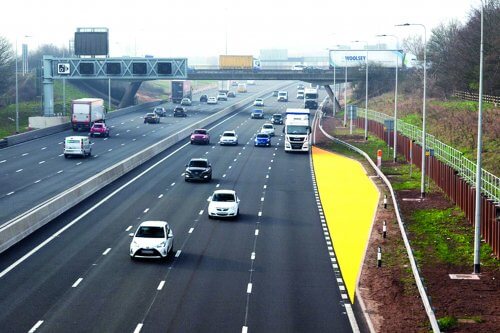The rollout of any new smart motorway schemes will be paused until a full five years’ worth of safety data is available, the Government has announced, and the Department for Transport (DfT) is to invest £900 million to improve safety on existing all lane running motorways.
In line with the Transport Committee’s most recent recommendations, the rollout of new smart motorways will be paused until a full five years’ worth of safety data becomes available for schemes introduced before 2020, after which the Government will assess the data and make a decision on its next steps with the scheme.
Although available data appears to show that smart motorways are comparatively the safest roads in the country in terms of fatality rates, the Government has said it will go further during the pause by ensuring current smart motorways without a permanent hard shoulder are equipped with what it calls ‘best-in-class technology and resources’ to make them as safe as possible.
This will include investing £390 million to install more than 150 additional emergency areas so drivers have more places to stop if they get into difficulty, giving an increase of around 50% in places to stop by 2025, and providing extra reassurance for users.
The DfT has welcomed the Transport Committee’s report, which endorsed its focus on further upgrading the safety of existing smart motorways rather than reinstating the hard shoulder. As concluded by the committee, evidence suggests hard shoulders do not always provide a safe place to stop, and by reducing motorway capacity, they could put more drivers and passengers at risk of death or serious injury if they were to divert onto less safe local roads.
Transport Secretary Grant Shapps said: “While our initial data shows that smart motorways are among the safest roads in the UK, it’s crucial that we go further to ensure people feel safer using them.
“Pausing schemes yet to start construction and making multimillion-pound improvements to existing schemes will give drivers confidence and provide the data we need to inform our next steps. I want to thank safety campaigners, including those who have lost loved ones, for rightly striving for higher standards on our roads. I share their concerns.”
The Governments response to the Transport Commitee builds on the progress already made against DfT’s 18-point action plan to improve smart motorway safety, announced in March 2020, including adding emergency areas and upgrading cameras to detect red X offences.
The measures in the review and Transport Committee response represent over £900 million of improvements in total, including the £390 million of new money for extra emergency areas, with the remainder of the funding delivering other measures, such as stopped vehicle detection and concrete central reservation barriers.
National Highways will also ramp up communications so drivers have better information about how to drive on smart motorways. While further data is being collected, the organisation will continue work to complete schemes that are currently in construction, which will all open with technology in place to detect stopped vehicles. These schemes are all more than 50% completed and The Government said that halting progress on them now would cause significant disruption for drivers.
Design work will also continue on those schemes already being planned, so they are ready to be constructed depending on the outcome of the pause. No preparatory construction work will take place.
Also, in line with the committee’s recommendations, National Highways will pause the conversion of dynamic hard shoulder motorways – where the hard shoulder is open at busy times – into all lane running motorways while it investigates alternative ways of operating them to make things simpler for drivers. It will also install technology to detect stopped vehicles on these sections.


